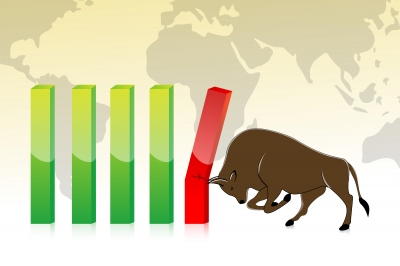
Today’s post is a guest post from Troy at The Financial Economist. Troy’s blog is all about different ways to invest. I am *super* excited for his post today because it is on something that I know nothing about, investing. I hope you enjoy! Thanks, Troy!
The first piece of investment advice that 99% of new investors will hear is “diversify, diversify, diversify”. Why? The theory goes as following:
Don’t put all your eggs in one basket, because if one basket breaks, you won’t be penniless and out on the street.
Seems reasonable, right? In a bull market, your gains will offset your losses, and in a bear market, your gains will mitigate your losses. Growing up, we’ve all been taught this timeless adage, and now it’s just been applied to investing. All you have to do is buy a whole basket of different stocks, commodities, or currencies, and the losses will be offset by some of the gains.
The Problem
In the past couple of years, there has been a major problem with the concept behind diversification. It’s as if diversification no longer exists – 99% of assets have become super correlated. What “correlated” means is that when one asset goes up, so do all the others. Correlation makes diversification practically impossible (and useless if attempted) – if all assets are going to go up (or down) together, then diversifying or not diversifying yields the exact same result (no diversification)!
In the 1990’s and early 2000’s, correlation wasn’t an issue. But since the 2007 credit bubble, global markets have all become heavily correlated. These days, the media networks simply lump all the markets together and either refer to the markets as “risk-on” (prices going up) or “risk-off” (prices going down). So what is the cause behind this sudden increase in correlation?
- These days, more and more traders are quants – mathematical nerds who build computer models that trade the markets. The funny thing is, all these computer models end up becoming very, very similar, to the point where everyone’s trading the same markets and making the same trades. Thus, these quants trade every single market with the same strategy, thereby reducing any diversification that may have existed before. (Imagine everyone moving together like a herd).
- Thanks to the internet revolution, asset management and investing is now being done on a global scale. So if investors are losing a lot of money in U.S. equities (stocks), then they’re going to have to sell their assets in China, Europe, and Japan to make up for their cash shortfalls. What happens? All the global markets go up and down in sync, thereby virtually eliminating diversification. In a global world, everyone is doing the same thing.
For example, in the past emerging markets were a good offset for U.S. equities – emerging markets would move in the opposite direction of American stocks. However, since 2008 this is no longer the case – U.S. stocks and foreign markets are moving in lockstep. Similarly, investors used to preach “buy at least 10 stocks to diversify your portfolio”. These days, this no longer seems like a viable option, because almost all stocks are going up or down at the same time.
The Solution
So is diversification dead? On paper, yes. In reality, no. This is because “diversification” is misunderstood.
What investors have often misunderstood about “diversification” is that one should focus on the market’s drivers, not the price.
This right here is the biggest misunderstanding about diversification – investors think that diversification means to invest in assets whose prices are non-correlated. The truth is, correlation is an on-off arrangement – at times, certain assets will be correlated and at other times that correlation will disappear. Thus, diversifying in 2 different markets because the markets’ prices are non-correlated is pointless – eventually, they will become correlated.
What you should do is invest in assets whose reasons for going up or down are different. Invest in the underlying cause, not the symptoms.
Let’s look at things this way. On paper, gold and stocks seem to be correlated – recently, they’ve been moving in the same direction in sync. HOWEVER, the drivers behind these markets are different. Gold is driven by inflation (inflation goes up, gold prices go up). Stocks, on the other hand, are driven by economic data, of which inflation is but ONE COMPONENT. Hence, although gold and stocks are correlated at this moment in time, eventually they will become un-correlated because their driver’s are different.
So how do you find assets that are driven by different factors?
Simple – all assets are influenced by 2 sets of 2 factors (inflation up/down & economic growth up/down), which combine to create 4 scenarios.
- Inflation increasing, economic growth increasing.
- Inflation increasing, economic growth decreasing.
- Inflation decreasing, economic growth increasing.
- Inflation decreasing, economic growth decreasing.
To truly diversify, you need to find assets that perform differently in the above 4 scenarios. That’s the key. How do you do that? Backtest – look at history and see which assets historically performed differently in the 4 scenarios.
Like this post? This was written by Troy, investor, trader, and avid snowboarder (yea, I know – irrelevant to this post). When I’m not working on my investments or doing physical exercises, I like to blog at The Financial Economist. Feel free to check out the blog, where I post thoughts on the global markets right now. Ciao!
Are you investing in anything right now? Do you try to diversify your investments?



Hey, I’ll be around for any comments.
Excellent explanation. I think one classic example is bond prices and interest rates since they have an inverse relationship with each other. That’s why I have a bond index fund in my portfolio to give myself some protection when market prices fall.
Personally, I stay away from bonds because I don’t understand them enough. But if you understand them, then by all means you should invest in them.
Great explanation Troy! Diversification is largely useless if all your investments are highly correlated, which has been an issue the past few years. I actively look to not have a high correlation, though that is easier said than done at times.
Yea, it can be pretty frustrating at times when you can’t find non-correlated assets. Correlation (like analogue investing) is an on-off deal.
This is probably because I haven’t started investing yet, but I always thought that’s what diversification meant! Now I’ll be armed for arguments for price diversification, though.
Glad you liked it.
Thank you for explaining this in a way that was understandable and didn’t make me feel like I had to have a bachelor’s in finance to understand what you were talking about, which is how I normally feel when people start talking about investing.
While ‘quants’ are undoubtedly part of the problem of correlation, I think the global recession had more to do with it. Instead of thinking of how well different industries or even individual companies are doing it’s more how the ‘economy’ is doing. I think when the Fed stops propping up the market we’ll see the correlations start to rip apart again. It’ll probably be uncomfortable, but good in the long run.
A pocket Wi-Fi has its show of drawbacks and it might not be the top internet connection option to suit your needs.
As opposed to Cable as well as DSL web, it could be a little
bit more slowly and the level of quality of the network will not be as good.
However, you cannot find any question that this convenient
solution is a wonderful choice for anyone who desires to gain access to web regardless of
a moment position.